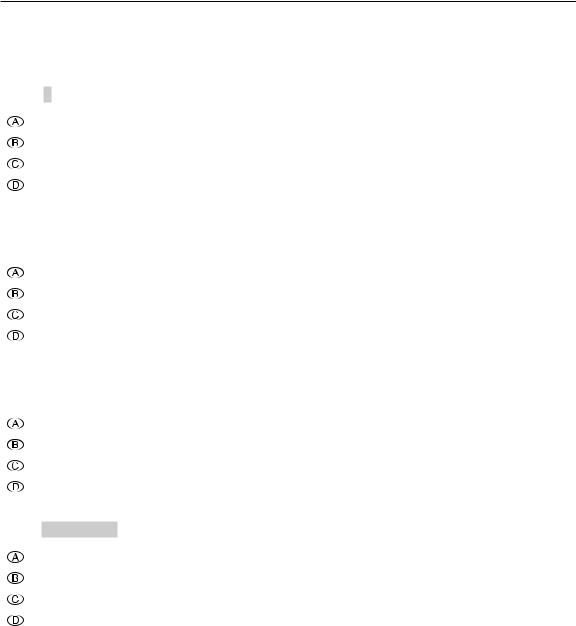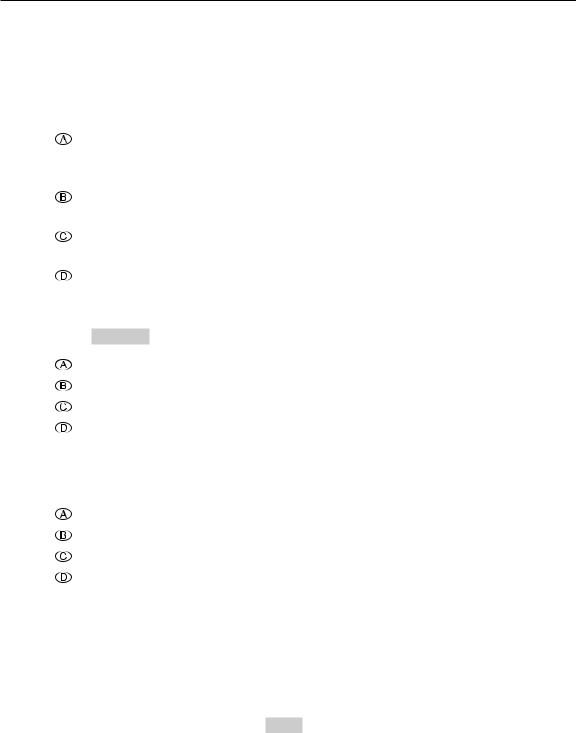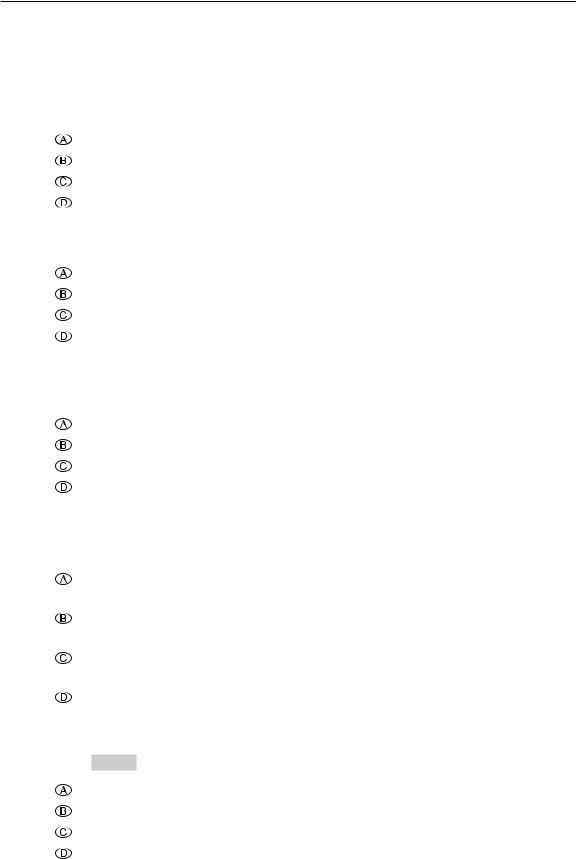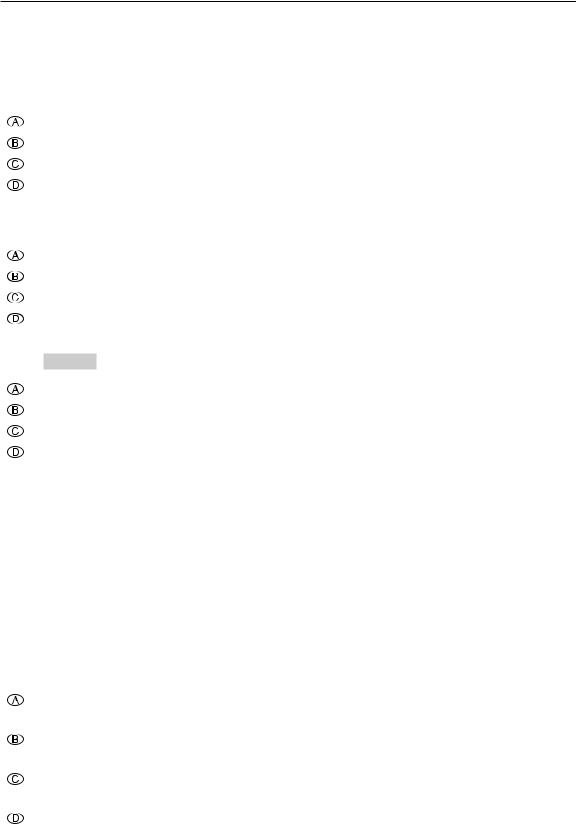
Каплан - тест для зачисления
.pdf
Pre-Arrival Test
Use for TAE & Cambridge
Copyright © 2009
All rights reserved. No part of this book may be reproduced, transmitted, or resold in any form, by photostat, microfilm, xerography, or any other means, or incorporated into any information retrieval system, electronic or mechanical, without the written permission of Kaplan, Inc.
11/02/2009

General Directions
This is a test of your ability to use the English language in an academic context. The test has two sections. The total time for the Reading section is one hour and the total time for the writing section is 30 minutes. Each section of the test begins with a set of specific directions. Be sure you understand what you are to do before you begin work on a section.
In the Reading section, you will read three passages and answer questions about them.
In the Writing section, you will read a question and then write an essay that responds to the question.
For the Reading section, do not mark your answers in this test book. You must put all of your answers on the separate answer sheet that you have been given. When marking your answer to a question on your answer sheet, be sure to fill in the answer space corresponding to the letter of your choice. Fill in the space so that the letter inside the oval cannot be seen, as shown in the example below.
Sample Answer
Mark only one answer for each question. If you change your mind about an answer after you have marked it on your answer sheet, completely erase your old answer and then mark your new answer. You must mark the answer sheet carefully so that the test-scoring machine can accurately record your test score.
For the Writing section, do not write your essay in this booklet. Write your essay on a separate sheet of paper.

Reading
In this section of the test, you will read three passages. You will be tested on your ability to understand them by answering several questions on each passage.
While you read, you may take notes. You can then use your notes when answering questions.
Most questions are worth one point. Questions that are worth more than one point have a special note telling you how many total points they are worth.
You will have 60 minutes to read the three passages and answer all the questions. If you finish the questions before 60 minutes is up, you can go back and review your work in this section.

Reading
Passage 1
The Anasazi
The Pueblo Indians of today, who live mostly in New Mexico and Arizona in the southwestern United States, are descendants of the Anasazi culture. The history of the Anasazi has been divided into several periods. During the Archaic Period (8000 b.c.–300 b.c.) and the Ancient Cultures (300 b.c.–100 b.c.), the Indians hunted game and collected plants and seeds. They moved their campsites often and over great distances.
The Basket Maker phase dates from about 100 b.c., when they began to develop agriculture, to a.d. 500. Throughout this period, the Indians remained heavily dependent on hunting and gathering. The game they sought generally consisted of deer, antelope, and rabbit. On occasion, special hunting parties would be sent to the plains to the east in search of bison. Dogs and turkeys were the first animals to be domesticated. Small villages started to appear. These villages had several pit houses, which were dwellings dug into the ground with ramped entrance ways, roof support posts, central fireplaces, and domed roofs covered with brush and adobe or mud. Underground pits for storing wild and grown food, lined with stone slabs to keep out the desert heat, were located both inside and outside the pit houses.
By a.d. 500, agriculture, particularly corn, began to play a more dominant role in the culture than hunting and gathering, and thus began the Modified Basket Maker Period (a.d. 500–700). During this period the Anasazi developed the skill of making pottery. Their food storage pits evolved into semisubterranean homes and ceremonial chambers. Toward the end of the Modified Basket Maker Period, above-ground stone construction began to appear.
The Classic Period (a.d. 700–1300), saw many changes. The Anasazi made a vast territorial expansion, encompassing central Utah, southern Colorado, and Northern Mexico, but deserting the northernmost regions of their territory. The people began to use irrigation to cultivate several varieties of corn and cotton. Pottery, basketry, weaving, architecture, jewelry, and other arts reached new heights, and trade within the Anasazi area and with neighboring groups was conducted at a tremendous rate, considering all travel was by foot.  Populations were concentrated into large, multistoried, terraced dwellings built into the recesses of cliffs and in other easily defensible locations, such as mesa tops and caves.
Populations were concentrated into large, multistoried, terraced dwellings built into the recesses of cliffs and in other easily defensible locations, such as mesa tops and caves.  The rooms of these dwellings were rectangular, with thick, flat roofs.
The rooms of these dwellings were rectangular, with thick, flat roofs.  The roof of one home could be reached from the level below by a ladder.
The roof of one home could be reached from the level below by a ladder.  The rooms contained no windows or doors but were accessed through a trap door in the roof, assuring protection from enemies. The ceremonial chamber, called a kiva, was a round space used for rituals and decision-making gatherings by the males of the tribe, and remained subterranean. However, by the end of the period, many large centers of life were abandoned, possibly due to drought, overuse of resources, and other population pressures, or because of invading bands of Navajo and Apache. Starting in the 1100s, people began moving south, often into the sparsely populated, mountainous regions of central Arizona and New Mexico. Abandonment reached a crescendo in the late 1200s, and by 1300 the entire San Juan River drainage area had been abandoned.
The rooms contained no windows or doors but were accessed through a trap door in the roof, assuring protection from enemies. The ceremonial chamber, called a kiva, was a round space used for rituals and decision-making gatherings by the males of the tribe, and remained subterranean. However, by the end of the period, many large centers of life were abandoned, possibly due to drought, overuse of resources, and other population pressures, or because of invading bands of Navajo and Apache. Starting in the 1100s, people began moving south, often into the sparsely populated, mountainous regions of central Arizona and New Mexico. Abandonment reached a crescendo in the late 1200s, and by 1300 the entire San Juan River drainage area had been abandoned.
During the Regressive Period, from 1300 to 1700, houses became less elaborate. The architecture does not show the careful construction characteristic of the previous period. Some pottery (but certainly not all) was not constructed or decorated as carefully as it had been previously. In fact, it showed new developments; geometric patterns were largely replaced by naturalistic representations of birds, animals, insects, and the human figure; glazing was frequently used. In addition, many of the

Reading
villages were founded that are inhabited today. Some researchers believe that it is possible that the Anasazi would have become truly urban if Spanish exploration had not altered the course of events drastically.
Early in the Modern Pueblo Period (1700 to the present), cattle, goats, horses, and sheep were introduced by Spanish explorers. Cotton was replaced by wool as a textile for weaving clothing and blankets. The Pueblo people, as they are now known, continued to develop, establishing an egalitarian form of government and sophisticated irrigation systems, and making further artistic developments in pottery, weaving, jewelry, leatherwork, and other crafts.
Today, there are 19 Pueblo communities in the American Southwest, divided into several clans. The people still participate in governing themselves and maintaining their traditional religious ceremonies.
1.It can be inferred from the passage that one reason that the Anasazi culture survived was because of
its incorporation of other ethnic groups
its adoption of the culture of the Spanish explorers
its continued advances in agriculture and building design its ability to maintain trading relationships with other tribes
2. The term ramped in the passage is closest in meaning to
built-up paved sloped wide
3. Why does the author mention ladders in paragraph 4?
To describe a technological advancement made in the Classic Period
To describe how the Anasazi got to the roofs of their dwellings
To describe a tool the Anasazi acquired from the Spanish
To describe how the Anasazi accessed the nearby cliffs and mesas
4.According to the passage, which of the following were introduced to the Anasazi by the Spanish explorers?
Various domesticated animals
An egalitarian form of government
New tools for weaving cotton and wool
Improved irrigation systems

Reading
5. The word it in the passage refers to
period pottery architecture construction
6.Which of the following best describes the changes from the Basket Maker Period to the Modified Basket Maker Period?
Cultivation of crops largely replaced hunting and gathering.
Food was stored in above-ground buildings made of stone.
Ceremonial themes dominated pottery designs.
Containers and baskets were made from corn by-products.
7.From the information in paragraph 5, it can be inferred that some researchers feel the Anasazi were capable of
building cities defeating the Spanish
calculating astronomical events exploiting underground water sources
8. The term a crescendo in the passage is closest in meaning to
a peak
a low point an end
a turning point
9.Look at the four letters ( ,
,  ,
,  , and
, and  ) in the passage that show where the following sentence could be inserted.
) in the passage that show where the following sentence could be inserted.
They measured about two by three meters, large enough for several people to sleep in.
Where would the sentence best fit in the passage? Choose the letter for the square where this sentence should be added and fill in the corresponding answer choice on your grid.

Reading
10.Which of the following sentences most closely expresses the important information in the highlighted sentence in the passage?
The underground feature of the chamber was unchanged, but the purpose of it altered somewhat, being used for certain spiritual and meeting purposes by the men.
Though the ceremonial chamber, called a kiva, was basically unchanged, its purpose became strictly religious and only males were permitted to use it.
A kiva was different from a subterranean ceremonial chamber used by the men in its essential shape and purpose.
The round room, known as a kiva, which was used by the men as a meeting place for religious ceremonies and planning sessions, was kept below ground.
11. The word elaborate in the passage is closest in meaning to
complex plentiful sturdy crowded
12.Which of the following is mentioned as a consequence of the development of agriculture by the Anasazi?
Villages
Hunting tools
A writing system
Herbal medicine
Passage 2
Magical Realism
The definition of “magical realism” in literature is one that has been widely debated by authors and literary critics alike. Some Latin American critics, author Alejo Carpentier most prominent among them, believe that magical realism is a uniquely Latin American concept. Other critics feel that the term refers to a genre of fiction writing that spans geographical, cultural, and political boundaries. Still others claim that the term magical realism applies only to a select group of South American authors who created works of literature in the middle part of the 20th century. This debate contributes to the difficulty of defining a term that can refer to such a diverse body of literature. What exactly is magical realism?
The term was first coined in the early 1920s by Franz Roh, a German art critic. Roh used the term “magical realism” to describe paintings in which everyday life was depicted in a way that did not conform to ordinary reality. For Roh, the artwork had to have an element of the impossible, and would very often show a realistic setting with one or two unrealistic features. An example of this would be a

Reading
painting that depicts an Arab asleep in the desert with a camel lying next to him, and a lion watching over them both. Most people are aware that lions cannot live in the desert, yet this painting is by no means surreal—or without basis in reality—because the Arab, the camel, and the desert together comprise a setting based on ordinary reality.
The painting then, is not surreal, nor could it have been called realistic—something that depicts a reallife situation in a fixed moment of time. While the images of the Arab and the camel in the desert are quite realistic and were painted in a realistic style, the addition of the lion, an element that seemingly should not have been present in the desert, takes the painting out of the realm of the realistic and brings it into another realm entirely: the realm that Roh named magical realism.
How then, does this description of magical realism apply to literature? Magical realism in literature is often described as fiction that connects the real world with the imaginary world. Works of magical realism combine real life and the fantastic in such a way that the magical elements become part of ordinary reality; the magical elements are no longer “magical,” but merely extensions of ordinary reality. Whereas realistic works contain an opposition between magic and reality, magical realism blurs the line of this opposition, making it difficult to see where reality ends and magic begins. In the realm of magical realism, myths, legends, rituals, and tradition are emphasized over empiricism and technology. Unlike surrealism, the worlds of magical realism are not completely imagined. 
The literature of magical realism aims to convey the reality of worlds that do not ordinarily exist.  Works of magical realism share several characteristics, including the way that time is depicted. In works of magical realism, time is not linear, as it is in ordinary reality. Often, it seems to double back on itself, so that events in the past, present, and future can occur out of sequence. Another feature shared by the genre is the subjectivity of cause and effect. In ordinary reality, causes and their effects are linear, predictable, and always proceed from cause to effect. In magical realism, causal agents do not always have predictable effects, and likewise, effects are not always traceable to expected causes. Works of magical realism often allow for the co-existence of logical contradictions; in fact, the interplay of contradicting elements is the background reality for many works of magical realism.
Works of magical realism share several characteristics, including the way that time is depicted. In works of magical realism, time is not linear, as it is in ordinary reality. Often, it seems to double back on itself, so that events in the past, present, and future can occur out of sequence. Another feature shared by the genre is the subjectivity of cause and effect. In ordinary reality, causes and their effects are linear, predictable, and always proceed from cause to effect. In magical realism, causal agents do not always have predictable effects, and likewise, effects are not always traceable to expected causes. Works of magical realism often allow for the co-existence of logical contradictions; in fact, the interplay of contradicting elements is the background reality for many works of magical realism. 
Magical realism is a term that can describe any body of literature that shares most of the criteria described above. Like any other genre, there will always be some discussion about whether certain works fit neatly into it.  Although a solid definition of the term is still elusive, the characteristics described above should help to determine whether a work fits into the genre.
Although a solid definition of the term is still elusive, the characteristics described above should help to determine whether a work fits into the genre.
13. The word spans in the passage is closest in meaning to
crosses describes creates discusses

Reading
14.According to the information in paragraph 1, what do some critics say concerning magical realism?
It was a term originally used to describe the works of Franz Roh.
It was more popular prior to the 20th century.
It is a genre that includes both fiction and nonfiction works.
It is a term reserved only for works by Latin American authors.
15. Based on information in paragraph 2, it can be inferred that Franz Roh did NOT
use the term magical realism to describe literature agree with the original definition of magical realism consider his own work to be magical realism
see a difference between surrealism and magical realism
16.In the painting described in paragraphs 3 and 4, which of the following is identified as being an unrealistic feature?
The Arab
The camel
The lion
The desert
17.Which of the following sentences most closely expresses the important information in the highlighted sentence in the passage?
Magical realism tries to show the magic that lies just below the surface of ordinary reality.
Fantastic elements in magical realism are presented as if they were part of reality itself.
Literature that falls into the genre of magical realism usually contains contradiction between reality and magic.
Magical realism often depicts characters who have magical or unreal powers and abilities.
18. The word convey in the passage is closest in meaning to
deny portray remove mock

Reading
19. The word it in the passage refers to
magical realism time
ordinary reality a work
20. In paragraph 5, the author explains the concept of magical realism by
defining it according to Franz Roh contrasting it with surrealism identifying some of its characteristics comparing it to a genre of painting
21. The word interplay in the passage is closest in meaning to
display interpretation relationship cooperation
22.Look at the four letters ( ,
,  ,
,  , and
, and  ) in the passage that show where the following sentence could be inserted.
) in the passage that show where the following sentence could be inserted.
Rather, they are based on reality as it actually exists, or perhaps as it is depicted in religious traditions or allegories.
Where would the sentence best fit in the passage? Choose the letter for the square where this sentence should be added and fill in the corresponding answer choice on your grid.
23.Which of the following statements most accurately reflects the author's opinion about magical realism?
Because magical realism blends elements of the real and the unreal, many readers may find it difficult to read at first.
While it may be difficult to define the genre, certain works can clearly be considered examples of magical realism.
Magical realism is one of the most creative genres of fiction, and among the most difficult for authors to master.
Critics should not worry about whether a particular work fits the definition of magical realism, and should instead focus on the quality of the work itself.
10
